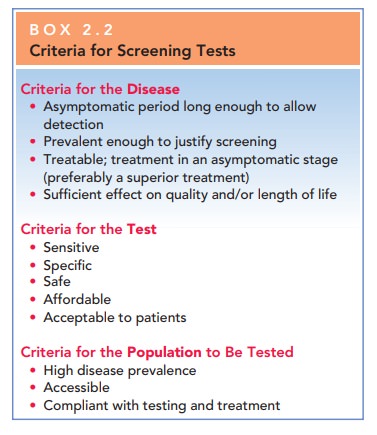Chapter: Obstetrics and Gynecology: The Obstetrician-Gynecologist’s Role in Screening and Preventive Care
Secondary Prevention: Periodic Assessment and Screening
SECONDARY PREVENTION: PERIODIC ASSESSMENT AND SCREENING
Periodic assessments conducted at
regular intervals (e.g., annually) are an integral part of preventive health
care and include screening, evaluation, and counseling. Recom-mendations for
periodic health assessments and screening are segregated by age group and are based
on risk factors . Assessment should include a thorough medical
history, physical examination, and laboratory testing.
The
findings elicited from the history and physical examination and results of
laboratory tests help guide interventions and coun-seling and may reveal
additional risks that require targeted screening or evaluation.
The recommendations presented in
Appendix B have been selected from many sources. A variety of factors have been
considered in recommending the assessments and screening tests, such as the
leading causes of morbidity and mortality in each age group. Other factors are
chronic health conditions that limit activity of working-age adults in the
United States, such as arthritis or other muscu-loskeletal disorders, and
circulatory disorders that become more prevalent as women age.
Characteristics of Screening Tests
The principle behind routine
screening is to detect the pres-ence of disease in asymptomatic individuals
without specific risk factors. The diseases screened for should be prevalent in
the population and amenable to early intervention. Screen-ing tests are
currently available for a variety of cancers, meta-bolic disorders, and
sexually transmitted diseases. Examples of screening tests are the Pap test and
mammography
Not every disease can be detected
by screening, and screening is not cost-effective or feasible for every
disease. The concepts of sensitivity
and specificity are used to
de-scribe the efficacy of screening tests in detecting a dis-order. The
sensitivity of a test is the proportion of affected individuals that test
positive on the screening test. The specificity is the proportion of unaffected
individuals that test negative on the screening test. An effective screening testshould be both sensitive (it has a high
detection rate) and specific (it has a low false-positive rate). Other
criteria for effectivescreening tests pertain to the population being tested
and the disease itself (Box 2.2).

Cancer Screening
Tests are available to detect
some, but not all cancers. There is no screening test with the requisite
sensitivity and speci-ficity to detect ovarian cancer. Women should be educated
about the early signs and symptoms of ovarian cancer that may aid in earlier
diagnosis. Likewise, screening tests are not avail-able for endometrial,
vaginal, or vulvar cancers. Endome-trial cancer can often be diagnosed at an
early stage based on symptoms.
Endometrial,
vulvar, and vaginal biopsies are not screening tests.
Related Topics